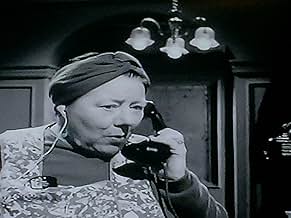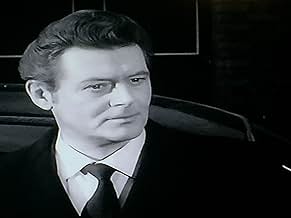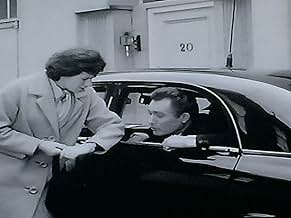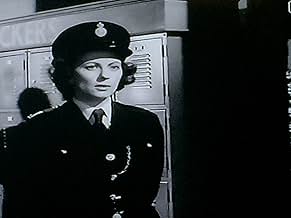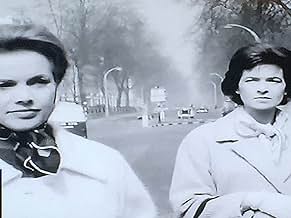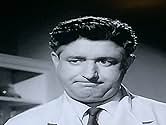Füge eine Handlung in deiner Sprache hinzuScotland Yard investigate when a woman, apparently the estranged wife of a London painter, is murdered with a shotgun in rural Surrey at the same time as the artist's striking model with her... Alles lesenScotland Yard investigate when a woman, apparently the estranged wife of a London painter, is murdered with a shotgun in rural Surrey at the same time as the artist's striking model with her long black hair disappears.Scotland Yard investigate when a woman, apparently the estranged wife of a London painter, is murdered with a shotgun in rural Surrey at the same time as the artist's striking model with her long black hair disappears.
Frank Pettitt
- Fred
- (as Frank Pettit)
Reginald Hearne
- Doctor
- (as Reggie Hearne)
Empfohlene Bewertungen
"Serena" is one of those films that, after I've watched it, I reflect back on the plot, wonder how convincing it all was, and debate whether to watch the film again to check! Certainly I had to think back about some of the scenes, but my eventual judgement was that it was all reasonably coherent.
Unusually (as a fan of postwar B films shot in and around London), I failed to recognise many of the supporting cast, with the exception of Peter Glaze as the station clerk at Victoria. (He went on to co-host "Crackerjack", a popular TV programme of my childhood.)
Honor Blackman's star potential was very evident, and Patrick Holt made a reasonable police inspector. The acting of several others was poor - in particular I was surprised to see that John Horsley, as the family solicitor, was an established actor, so amateurish were his reactions when he was being questioned. The trailing of Ann Rogers after she'd left the church looked very clumsy.
I was a little surprised to see that the film lasted only an hour - it seemed longer. Overall, it was very acceptable.
Unusually (as a fan of postwar B films shot in and around London), I failed to recognise many of the supporting cast, with the exception of Peter Glaze as the station clerk at Victoria. (He went on to co-host "Crackerjack", a popular TV programme of my childhood.)
Honor Blackman's star potential was very evident, and Patrick Holt made a reasonable police inspector. The acting of several others was poor - in particular I was surprised to see that John Horsley, as the family solicitor, was an established actor, so amateurish were his reactions when he was being questioned. The trailing of Ann Rogers after she'd left the church looked very clumsy.
I was a little surprised to see that the film lasted only an hour - it seemed longer. Overall, it was very acceptable.
The film opens with a woman being shot dead. The victim is assumed to be Ann Rogers, the owner of the cottage in which the body is found, and the prime suspect is her estranged husband, an artist named Howard Rogers. Although Howard claims to have an alibi, he also has an obvious motive to want his wife dead. He has been having an affair with his model, Serena Vaughan, but Ann, a devout Catholic, has refused to grant him the divorce he would need to marry Serena.
And then the situation is turned upside down by a series of coups de cinema. Taken to identify the body, Howard claims it is not that of his wife, and Ann suddenly turns up alive and well, saying that she wants a reconciliation with her husband. Howard produces a witness who can support his alibi, and Ann tells the police that the murdered woman was Claire Matthews, a friend who was staying with her and was presumably killed by mistake for Ann herself. Suspicion now shifts to Serena Vaughan, who is missing. There is, however, to be one more devastating plot twist.
"Serena" was originally made in black-and-white as a B-movie, which explains its brevity, little more than an hour in length. Yet it is an intriguing, well-plotted murder mystery which keeps the audience guessing about who we can trust and which information we can take at face value. Although it was made as long ago as 1962, it still turns up regularly on British television, a testament to its durability. 7/10
A goof. The police officer investigating the crime holds the rank of Detective Chief Inspector, but after he shows his identity badge to a potential witness, the man addresses him as "Superintendent".
And then the situation is turned upside down by a series of coups de cinema. Taken to identify the body, Howard claims it is not that of his wife, and Ann suddenly turns up alive and well, saying that she wants a reconciliation with her husband. Howard produces a witness who can support his alibi, and Ann tells the police that the murdered woman was Claire Matthews, a friend who was staying with her and was presumably killed by mistake for Ann herself. Suspicion now shifts to Serena Vaughan, who is missing. There is, however, to be one more devastating plot twist.
"Serena" was originally made in black-and-white as a B-movie, which explains its brevity, little more than an hour in length. Yet it is an intriguing, well-plotted murder mystery which keeps the audience guessing about who we can trust and which information we can take at face value. Although it was made as long ago as 1962, it still turns up regularly on British television, a testament to its durability. 7/10
A goof. The police officer investigating the crime holds the rank of Detective Chief Inspector, but after he shows his identity badge to a potential witness, the man addresses him as "Superintendent".
A jacketed figure carrying a shotgun opens a door at 3PM and shoots a woman. Some time later, there's a knock at the door of painter Emrys Jones' flat. He the black-haired woman embracing him to leave. She goes out the back door. At the front door is Chief Inspector Patrick Holt. Jones' estranged wife has been shot and killed. He explains he spent the entire day shooting pigeons with his model, Serena Vaughn. She'll confirm this. However, the corpse turns out not to be Jones' wife, who turns up later in fine fettle as Honor Blackman. But there's a dead woman, and where the dickens is Serena?
It's a nifty little mystery that I didn't unravel until after they revealed it, and the telling clue, although obscure to me, is fair enough. There's also the pleasure of looking at Miss Blackman and the story is told quickly and efficiently. My only problem with it is the random nature of Johnny Gregory's score; surely there's nothing amusing about a carload of copper going off to look for clues.
It's a nifty little mystery that I didn't unravel until after they revealed it, and the telling clue, although obscure to me, is fair enough. There's also the pleasure of looking at Miss Blackman and the story is told quickly and efficiently. My only problem with it is the random nature of Johnny Gregory's score; surely there's nothing amusing about a carload of copper going off to look for clues.
I am very respectful of the Butcher Studios. They put out many programmers of sufficient quality to make you forget the main feature. SERENA is no masterpiece, but it is very competently directed by Peter Maxwell, who extracts quality performances from the entire ensemble, the stunningly beautiful Honor Blackman above all.
Director Maxwell very cleverly opens the film with the murder of Mrs Rogers, doing it in such a way that it becomes clear that the spectator will only get the data that he, Maxwell, is willing to release. The murder shows neither the face of the deceased nor that of the killer, and the door into Mrs Rogers' apartment is opened by the murderer's hand. One important clue: the murderer goes right in, without using any key to get in and find its mark, suggesting someone familiar enough with the abode to know its layout.
Holt makes a very classy, clued up and insistent police inspector. He never says more than he needs, cleverly and tirelessly reading all the signs until he plays the decisive identifying card that beats the criminal(s).
Excellent cinematography by Steven Dade, crisp editing by Morrison, and pleasant music by Johnny Gregory only enhance the quality of Maxwell's direction and of the Hearne and Abraham screenplay.
Of course SERENA forces you to suspend your disbelief here and there, and you can spot holes in the plot, but it is intelligently done with a shoestring budget and within a highly economical 59 minutes.
You will not waste your time if you watch it.
Director Maxwell very cleverly opens the film with the murder of Mrs Rogers, doing it in such a way that it becomes clear that the spectator will only get the data that he, Maxwell, is willing to release. The murder shows neither the face of the deceased nor that of the killer, and the door into Mrs Rogers' apartment is opened by the murderer's hand. One important clue: the murderer goes right in, without using any key to get in and find its mark, suggesting someone familiar enough with the abode to know its layout.
Holt makes a very classy, clued up and insistent police inspector. He never says more than he needs, cleverly and tirelessly reading all the signs until he plays the decisive identifying card that beats the criminal(s).
Excellent cinematography by Steven Dade, crisp editing by Morrison, and pleasant music by Johnny Gregory only enhance the quality of Maxwell's direction and of the Hearne and Abraham screenplay.
Of course SERENA forces you to suspend your disbelief here and there, and you can spot holes in the plot, but it is intelligently done with a shoestring budget and within a highly economical 59 minutes.
You will not waste your time if you watch it.
The late Honor Blackman (billed third), after starting out playing ingenues followed by several years in the doldrums, had by 1962 been reduced to working for Butchers. But she had by now adopted that swept-back mane that by the end of the year would be indelibly associated with Cathy Gale and the lioness she thereafter remained for the rest of her long life.
It may have been intentional that naming the film after the corpse at the centre of the action was a conscious nod to 'Laura'. But making the religion of the victim a central plot point remains an unusual touch.
It may have been intentional that naming the film after the corpse at the centre of the action was a conscious nod to 'Laura'. But making the religion of the victim a central plot point remains an unusual touch.
Wusstest du schon
- WissenswertesFinal film of Benedicta Leigh.
- PatzerInspector Gregory introduces himself to Howard Rogers as Detective Chief Inspector Gregory. However, later on in the film when he is interviewing the Railway station Luggage Clerk and shows his identification, the clerk responds with 'Superintendent'.
Top-Auswahl
Melde dich zum Bewerten an und greife auf die Watchlist für personalisierte Empfehlungen zu.
Details
- Erscheinungsdatum
- Herkunftsland
- Sprache
- Drehorte
- Blacksmith's Lane, Laleham, Staines-upon-Thames, Surrey, England, Vereinigtes Königreich(establishing shot showing street where victim is shot)
- Produktionsfirma
- Weitere beteiligte Unternehmen bei IMDbPro anzeigen
- Laufzeit
- 1 Std.(60 min)
- Farbe
- Seitenverhältnis
- 1.66 : 1
Zu dieser Seite beitragen
Bearbeitung vorschlagen oder fehlenden Inhalt hinzufügen


